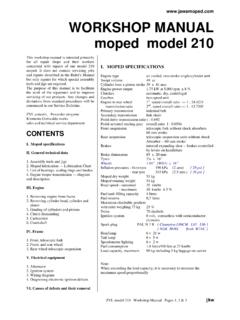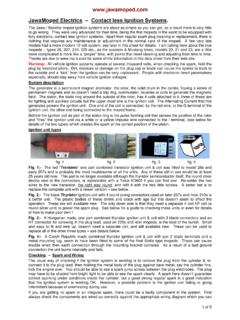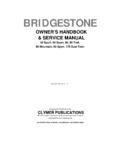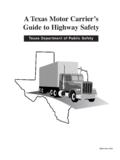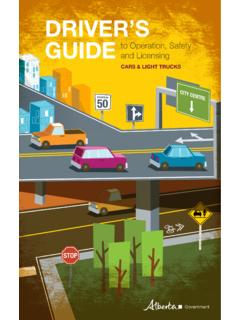Transcription of OPERATING AND MAINTENANCE INSTRUCTIONS …
1 AND MAINTENANCE INSTRUCTIONSJAWA MOPEDMOTOR DRIVEN CYCLE 50 ccMODEL M 210 Manufacteur: ZMV, . p. Kol rovoCzechoslovakiaThe moped is a single-track motor vehicle of simple design, easy to handle and special skill is required for its get well acquainted with it, we recommended, that you read this Owner's Handbook prior to its this way you will avoid any inconvenience and trouble, and the moped will serve you to your wish you many happy and carefree miles on your new mopedZMV, . p. Kol rovoCSFRThe design of the moped, its specifications, description and illustrations containedherein are liable to changes resulting from further development and Technical dataII. ControlsIII. Riding instructionsIV. MAINTENANCE and adjustmentsV.
2 Rear telescopic suspension unitsVI. ToolkitVII. TroubleshootingVIII. Spare partsBenefit yourself of the advantages offered to you by the automatic two-speed gearbox of your of the automatic function of the the engine has started, the moped starts moving in response to the opening of the throttle (accelerating)without any use of the other control elements on the handlebars (single speed moped only). By furtheracceleration (increasing the speed of the moped), the second gear is engaged automatically and riding uphill, the change to gear takes place addition to this control by road speed, the moped provides for a momentous control (depending on theturning of the twist grip).Thus you can use the controls of your machine in the following ways:1.
3 Starting at full throttle - sports style riding. The change from 1st to 2nd gear takes place at a and at a higher road Starting with only partly opened throttle is more economical. The change from 1st to 2nd gear takesplace at a lower engine speed and an increased road In city traffic, riding behind a slower vehicle in 2nd gear while decelerating by throttling down is moreeconomical and less noisy as when changing down to 1st When riding in 2nd gear at a certain steady (free-running) speed, it is possible to change immediately tothe 1st gear and to accelerate effectively by turning down the Braking with the engine to a stop in the more economical and less noisy 2nd gear after thedisengagement of the starting clutch will avoid engine NUMBER IS LOCATED a.
4 On steering headb. on left-hand top side of engineIGNITION TIMING1 to mm before piston MIXTURE1:40 during first 400 km (200 miles)1:50 after break in1 of 11 jawa type 210 owners handbook pages 1 to 5 1 jawa Moped Main Parts1. Tail lamp, 2. Rear mudguard, 3. Tire pump, 4. Luggage carrier, 5. Tool kit, 6. Rear telescopic suspensionunit, 7. Intake air cleaner, 8. Fuel tank, 9. Fuel tank filler cap, 10. Handlebars, 11. Headlamp, 12. Frame, fork, 14. Front mudguard, 15. Rear wheel, 16. Exhaust silencer, 17. Pedal drive transmission chain, cranks and pedals, 19. Engine drive transmission chain, 20. Stand, 21. Engine drive disengaging lug,22. Alternator (under cover), 23. Exhaust pipe, 24. Engine, 25.
5 Spark plug with cable shoe, 26. Front wheel,27. TECHNICAL DATAE ngine type air-cooled single cylinderEngine capacity 49. c. s. (3 cu. in)Cylinder bore/piston stroke 39/41 ( ")Engine output kW at 5000 8%Clutches automatic centrifugal for single speed / automatic two-speed unitTransmission of driving in 1st. gear - overall ratio 1 to rear wheel in 2nd gear-overall ratio 1 single speed 20 MPH1 single speed 30 MPHP rimary transmission indented beltSecondary transmission stud link chainPedal drive transmission ratio1 start overall ratio 1 suspension telescopic front fork without shock absorbers 60 mm strokeRear suspension suspension units without shock absorbers 60 mm strokeBrakes internal-expanding shoe brakes controlled by levers on handlebarsBrake dimensions 85x20 mm ( x ")
6 Tires, front and rear 2 x 16"Tire inflation pressures -front 2 atm (196 kPa) (28 Lbs/in ) -rear 2,5 atm. (245 kPa) (35 Lbs/in )Moped weight51 kg - 112 load135 kg - 297 km/hFuel tank filling litres - 1 US ability25%Noise70 decibelsIgnition6 V, non-contact, semiconductor systemSpark plugPAL N7, CHAMPION L-89CM, L-85, L-86, NGK B6HS, BOSH - W7 ACHeadlamp6V/15 WTail lamp6V/5 W, 6V/10 WSpeedometer light6 : Over loaded moped (max. 100 kg) decreases of 11 jawa type 210 owners handbook pages 6 to 9 CONTROLSThe following few controls of the moped are easy to operate:a) Throttle twist grip (1, ) by the rotation of which the clutch is engaged or disengaged automaticallywhile the throttle is opened or closed and thus the vehicle accelerates or ) Front brake lever (2, ) and rear brake lever (3, ), by the depressing of which the vehicle isbraked and ) Light switch (Fig.
7 3)d) Buzzer push button ( )e) Fuel cock lever (Fig. 6,)f) Choke ( )g) Pedals (Fig. 8)h) Engine drive disengaging mechanism (Fig. 9)3 of 11 jawa type 210 owners handbook pages 10 to 12 RIDING INSTRUCTIONSB efore starting check: brakes tire pressures amount of fuel in the tank functioning light (while engine is running) correct tensioning of secondary fuel used in the moped is gas mixed with oil in the recommended ratio. Use regular gas and observe themixing ratio when filling the fuel tank using a funnel with a strainer when filling the mixing ratio - 1:40 during the break in period 1:50 after the break in a MopedOpen the fuel cock (Fig6) push in the choke pin ( ) as far as it will go the pin returns immediately into itsoriginal position but the air intake remains throttled the engine is supplied with a richer methods can be used for starting the Start Cold Engine in Summera) Pull up the moped on its stand, push in the choke pin, rotate the twist grip through one-half of its rotationrange, set the pedal forward at an angle of about 30 degrees from the vertical, depress the pedal energeticallyand engine should start.
8 If the engine does not fire, repeat this the engine has started running let it warm up and then rotate the twist grip as far as it will go to openthe choke. Then back off the twist grip so that the engine runs at idling speed and is ready to go. Jerk it fromthe stand on to the wheels and move off by accelerating (opening the throttle).DO NOT SIT ON THE MACHINE DURING THIS STARTING ) Starting by pedalling: With the vehicle standing on wheels push in the choke, and rotate the twist grip asdescribed in paragraph a). Use the pedals to start the engine. As soon as the engine fires accelerate byopening the the Engine in the Cold SeasonWhen the temperature drops below 0 C, it is necessary to modify the starting procedure as follows:-Proceed with the actual starting as in point a) with the only difference that the twist grip must be turned threequarters of its total rotation range to prevent the opening of the air intake flap.
9 Prolong the engine warm-upperiod in proportion to the falling : For safety reasons, the starting method as per point b) is not recommended on ice and snowcovered : IF NECESSARY, YOU CAN ASSIST THE ENGINE BY PEDALLING, ESPECIALLY WHENCLIMBING A LONG OR STEEP of 11 jawa type 210 owners handbook pages 13 to 16 in a new machineThe way a new moped is run affects its life, performance, andfuel observe the following INSTRUCTIONS during the breakin ) Mix the fuel regular gas with two cycle oil in 40:1 : Use two cycle oil only!b) Use this fuel during the break-in period (for about 400 km-200 miles) and do not exceed the maximum speed over(25 km/h for 30 km moped)(35 km/h for 40 km moped)(40 km/h for 50 km moped)with the throttle opened no more than by 1/2 to 3/4 of the ) When riding down a long hill do not throttle down but decelerate by applying the brakes, and never exceedthe ) Remember that the engine is cooled less efficiently when riding in the warm season with the wind in ) Do not let the engine idle too long and do not race it unnecessarily after stopping the and stoppingIf you have to slow down, release the twist grip and apply the brakes by pulling the brake levers ( ).
10 Proceed in the same way to stop the moped. The reduction of engine speed results in the disengagement ofthe driving clutch, and the engine runs at idling speed. To continue the ride, just accelerate (turn the twistgrip). The driving clutch engages and the moped starts moving. At the end of the trip stop the engine bydepressing kill switch push button and shut off the fuel supply by turning the lever of the fuel cock (Fig. 6)Disengagement of engine driveTo disengage the drive, the engine must be off and the moped at a you intend to use the moped as a bicycle, (after using up the fuel) pull the driving lug (in the directionaway from the engine) and rotate it 90 degrees clockwise or counter clockwise, and then release it ( ).
